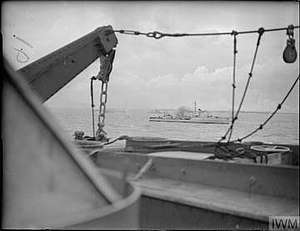HMS Cottesmore (L78)
HMS Cottesmore was a Hunt-class destroyer of the Royal Navy.
 Cottesmore during the invasion of Normandy on 6 June 1944 | |
| History | |
|---|---|
| Name: | HMS Cottesmore |
| Namesake: | Cottesmore Hunt, Rutland |
| Ordered: | 21 March 1939 |
| Builder: | Yarrow, Scotstoun |
| Laid down: | 9 June 1939 |
| Launched: | 5 September 1940 |
| Commissioned: | 29 December 1940 |
| Homeport: | Sheerness |
| Identification: | pendant number: L78 |
| Honours and awards: |
|
| Fate: | Sold to Egyptian Navy 20 April 1950 |
| Badge: | On a Field Red, a lozenge Gold charged with a fret Red surmounted by an annulet Black |
| Name: | Ibrahim el Awal |
| Acquired: | 20 April 1950 |
| Renamed: | Mohammed Ali el Kebir, Port Said |
| Refit: | 17 July 1950 J. Samuel White, Cowes |
| Homeport: | Port Said |
| General characteristics [1] | |
| Class and type: | Type I Hunt-class destroyer |
| Displacement: |
|
| Length: | |
| Beam: | 29 ft (8.84 m) |
| Draught: | 7 ft 9 in (2.36 m) |
| Propulsion: |
|
| Speed: | 27.5 kn (50.9 km/h; 31.6 mph) |
| Range: | 2,500 nmi (4,600 km; 2,900 mi) at 20 kn (37 km/h; 23 mph) |
| Complement: | 146 |
| Armament: |
|
Construction and design
HMS Cottesmore was ordered from the Scottish shipbuilder Yarrow on 11 April 1939, as part of the second batch of ten Hunt-class destroyers, following on from the first batch of ten Hunts ordered in March that year.[2] The Hunts were meant to fill the Royal Navy's need for a large number of small destroyer-type vessels capable of both convoy escort and operations with the fleet, and were designed with a heavy anti-aircraft armament of six 4-inch anti-aircraft guns and a speed of 29 knots (33 mph; 54 km/h).[3][4] An error during design, which was only discovered once the first ship of the class Atherstone was built, meant that the ships as designed were dangerously unstable. To restore stability, the first 23 Hunts, including Cottesmore, were modified by removing a twin 4-inch mount, cutting down the ships' superstructure and adding ballast. These ships were known as Type I Hunts.[5][6] Later ships in the class had their beam increased, which allowed them to carry the originally intended armament, and were known as Type II Hunts.[7]
Cottesmore was 264 feet 3 inches (80.54 m) long between perpendiculars and 280 feet (85.34 m) overall. The ship's beam was 29 feet 0 inches (8.84 m) and draught 7 feet 9 inches (2.36 m). Displacement was 1,000 long tons (1,000 t) standard and 1,360 long tons (1,380 t) under full load. Two Admiralty boilers raising steam at 300 pounds per square inch (2,100 kPa) and 620 °F (327 °C) fed Parsons single-reduction geared steam turbines that drove two propeller shafts, generating 19,000 shaft horsepower (14,000 kW) at 380 rpm. This gave a speed of 27.5 knots (50.9 km/h; 31.6 mph).[8]
The ship's main gun armament was four 4 inch (102 mm) QF Mk XVI dual purpose (anti-ship and anti-aircraft) guns in two twin mounts, with one mount forward and one aft. Additional close-in anti-aircraft armament was provided by a quadruple 2-pounder "pom-pom" mount.[9][8] The ship was later modified by adding two single Oerlikon 20 mm cannon on the bridge wings.[10] Up to 40 depth charges could be carried.[8][11] The ship had a complement of 146 officers and men.[8]
Cottesmore was laid down at Yarrow's Scotstoun shipyard on 12 December 1939 and was launched on 5 September 1940. She was commissioned on 29 December 1940, with the Pennant number L78.[2][12]
Service
On commissioning, Cottesmore joined the 21st Destroyer Flotilla, based at Sheerness and employed on escorting convoys along the East coast of Britain, together with patrol duties and support for minelaying operations.[13]
Citations
- Lenton 1970, p. 87.
- English 1987, p. 16
- English 1987, pp. 7–9
- Friedman 2008, pp. 71–72
- English 1987, pp. 10–11
- Friedman 2008, pp. 75–77
- English 1987, pp. 11–12
- Lenton 1970, p. 87
- Gardiner & Chesneau 1980, p. 47
- Lenton 1970, p. 85
- Friedman 2008, p. 319
- Whitley 2000, p. 143
- English 1987, p. 53
Sources
- English, John (1987). The Hunts: A history of the design, development and careers of the 86 destroyers of this class built for the Royal and Allied Navies during World War II. World Ship Society. ISBN 0-905617-44-4.CS1 maint: ref=harv (link)
- Friedman, Norman (2008). British Destroyers and Frigates: The Second World War and After. Barnsley, UK: Seaforth Publishing. ISBN 978-1-84832-015-4.CS1 maint: ref=harv (link)
- Gardiner, Robert; Chesneau, Roger, eds. (1980). Conway's All The World's Fighting Ships 1922–1946. London: Conway Maritime Press. ISBN 0-85177-146-7.CS1 maint: ref=harv (link)
- Lenton, H.T. (1970). Navies of the Second World War: British Fleet & Escort Destroyers: Volume Two. London: Macdonald & Co. ISBN 0-356-03122-5.CS1 maint: ref=harv (link)
- Whitley, M. J. (2000). Destroyers of World War Two: An International Encyclopedia. London: Cassell & Co. ISBN 1-85409-521-8.CS1 maint: ref=harv (link)